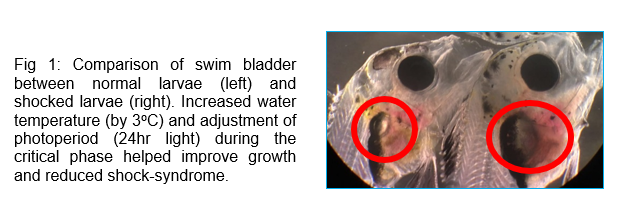DEVELOPMENT OF HATCHERY TECHNOLOGY FOR RED SNAPPER Lutjanus spp.
Red snapper (Lutjanus spp.) fingerlings are conventionally produced in extensive outdoor ponds in South East Asia and there has been limited success in using indoor tank systems, with reported low survival rates of ~1-2%. Our project aims to understand the key challenges in indoor hatchery production of red snapper and to develop a hatchery protocol for commercial-scale fry production. In our study, we had observed a significant display of shock-syndrome between day 15-25 of culture and most of the shocked larvae did not recover. The shocked larvae would struggle near the water surface and would sink to the tank bottom after some time. These larvae were observed with having overly inflated swim-bladders. This shock-syndrome would result in high mortality during the larval rearing period in indoor tank systems. Through a series of trials, we managed to overcome the shock-syndrome of red snapper larvae by adjusting the photoperiod. Apart from addressing the shock-syndrome issue, we have also refined our hatchery protocols through the use of small-sized rotifers during the first 5 days of culture; enrichment of live feeds; and culturing in a higher water temperature to speed up the larval growth. With these protocol refinements, we have managed to increase the survival rate by ten-fold, from the initial survival rate of ~1-2% to ~15-20%. We have also tested diets with natural pigment and established a fish harvesting method to achieve a crimson red appearance, thereby enhancing the marketability of cultured red snapper.
